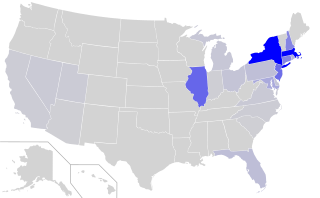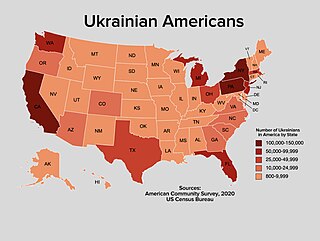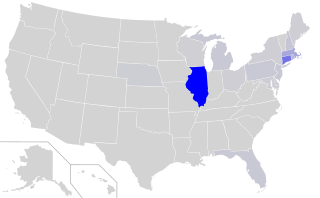
Brookline is a town in Norfolk County, Massachusetts, United States, and part of the Boston metropolitan area. An exclave of Norfolk County, Brookline borders six of Boston's neighborhoods: Brighton, Allston, Fenway–Kenmore, Mission Hill, Jamaica Plain, and West Roxbury. The city of Newton borders Brookline to the west. It is known for being the birthplace of John F. Kennedy.

Worcester is the second-most populous city in the U.S. state of Massachusetts and the 114th most populous city in the United States. Named after Worcester, England, the city had 206,518 people at the 2020 census, also making it the second-most populous city in New England, after Boston. Worcester is about 40 miles (64 km) west of Boston, 50 miles (80 km) east of Springfield, and 40 miles (64 km) north-northwest of Providence. Because it is near the geographic center of Massachusetts, Worcester is known as the "Heart of the Commonwealth"; a heart is the official symbol of the city. Worcester is the historical seat of Worcester County.

Quincy is a city in Norfolk County, Massachusetts, United States. It is the largest city in the county and a part of Greater Boston, being Boston's immediate southern suburbs. Its population in 2020 was 101,636, making it the seventh-largest city in the state. Known as the "City of Presidents", Quincy is the birthplace of two U.S. presidents—John Adams and his son John Quincy Adams—as well as John Hancock, the first signer of the Declaration of Independence and the first and third governor of Massachusetts.

Greek Americans are Americans of full or partial Greek ancestry. The lowest estimate is that 1.2 million Americans are of Greek descent while the highest estimate suggests over 3 million. According to the US census, 264,066 people older than five spoke Greek at home in 2019.

Greater Boston is the metropolitan region of New England encompassing the municipality of Boston, the capital of the U.S. state of Massachusetts and the most populous city in New England, and its surrounding areas. The most stringent definition of the region, used by the Metropolitan Area Planning Council, consists of most of the eastern third of mainland Massachusetts, excluding the Merrimack Valley and most of Southeastern Massachusetts, though most definitions include much of these areas and portions of southern New Hampshire.

Massachusetts, officially the Commonwealth of Massachusetts, is a state in the New England region of the Northeastern United States. It borders the Atlantic Ocean and Gulf of Maine to its east, Connecticut and Rhode Island to its south, New Hampshire and Vermont to its north, and New York to its west. Massachusetts is the sixth-smallest state by land area. With over seven million residents as of 2020, it is the most populous state in New England, the 16th-most-populous in the country, and the third-most densely populated, after New Jersey and Rhode Island.

Armenian Americans are citizens or residents of the United States who have total or partial Armenian ancestry. They form the second largest community of the Armenian diaspora after Armenians in Russia. The first major wave of Armenian immigration to the United States took place in the late 19th and early 20th centuries. Thousands of Armenians settled in the United States following the Hamidian massacres of the mid-1890s, the Adana massacre of 1909, and the Armenian genocide of 1915–1918 in the Ottoman Empire. Since the 1950s many Armenians from the Middle East migrated to the United States as a result of political instability in the region. It accelerated in the late 1980s and has continued after the dissolution of the Soviet Union in 1991 due to socio-economic and political reasons. The Los Angeles area has the largest Armenian population in the United States.

Albanian Americans are Americans of full or partial Albanian ancestry and heritage in the United States. They trace their ancestry to the territories with a large Albanian population in the Balkans and southern Europe, including Albania, Italy, Kosovo, North Macedonia and Montenegro. They are adherents of different religions and are predominantly Muslims and Christians, while some are irreligious.

Ukrainian Americans are Americans who are of Ukrainian ancestry. According to U.S. census estimates, in 2021 there were 1,017,586 Americans of Ukrainian descent representing 0.3% of the American population. The Ukrainian population of the United States is thus the second largest outside the former Eastern Bloc; only Canada has a larger Ukrainian community under this definition. According to the 2000 U.S. census, the metropolitan areas with the largest numbers of Ukrainian Americans are: New York City with 160,000; Philadelphia with 60,000; Chicago with 46,000; Detroit with 45,000; Los Angeles with 36,000; Cleveland with 26,000; Sacramento with 20,000; and Indianapolis with 19,000. In 2018, the number of Ukrainian Americans surpassed 1 million.

Lithuanian Americans refer to American citizens and residents of Lithuanian descent or were born in Lithuania.

Lebanese Americans are Americans of Lebanese descent. This includes both those who are native to the United States of America, as well as immigrants from Lebanon.

The Albanian Archdiocese, also known as the Albanian Orthodox Archdiocese in America, is one of three ethnic dioceses of the Orthodox Church in America (OCA). Its territory includes parishes, and missions located in seven states in the United States – California, Connecticut, Massachusetts, Michigan, New York, Ohio, and Pennsylvania. The current bishop of the archdiocese is Nikodhim (Preston).
Eastern Orthodoxy in North America represents adherents, religious communities, institutions and organizations of Eastern Orthodox Christianity in North America, including the United States, Canada, Mexico, Central America, and the Caribbean. Estimates of the number of Eastern Orthodox adherents in North America vary considerably depending on methodology.
The Hudson Incident was a 1907 controversy following the death and burial of Kristaq Dishnica, an Albanian immigrant to the United States, which catalyzed the foundation of the Albanian Orthodox Mission in America under the leadership of Fan Noli, eventually leading to the Orthodox Church of Albania's formation.

Massachusetts has an estimated population of 6.981 million as of 2022 according to the U.S. Census Bureau. This represents a −0.7% decrease in population from the 2020 census, when the population was 7.029 million. Currently, Massachusetts is the sixteenth most populous U.S. state.

The Boston metropolitan area has an active Chinese American community. As of 2013, the Boston Chinatown was the third largest Chinatown in the United States, and there are also Chinese populations in the suburbs of Greater Boston, including Quincy, Malden, Acton, Newton, and Lexington. As of 2006, Boston, Quincy, Malden, Newton, Brookline, and Cambridge house about half of all of the ethnic Chinese in Massachusetts, and as a whole, Chinese constituted the largest Asian ethnic group in the state.

There is a Vietnamese American population in Boston. As of 2012 Boston has the largest group of ethnic Vietnamese in the state. Other groups of Vietnamese are in Braintree, Chelsea, Everett, Lynn, Malden, Medford, Quincy, Randolph, Revere, and Weymouth. Vietnamese also live in more distant cities in the Boston combined statistical area and the area around Boston: Attleboro, Brockton, Fall River, Haverhill, Methuen, Lowell and Worcester.
There are 14,300 Albanian Americans in Illinois, 0.1% of the state's population, slightly above the national average of 0.07%. While still a small proportion of the population, Albanian Americans have contributed significantly to the food scene of Chicagoland, especially in the pizza and Italian cuisine industry. While Albanians often open up restaurants and markets that serve Albanian and Balkan cuisine and flare, they have a finesse in the Italian-style pasta and pizza industry.















